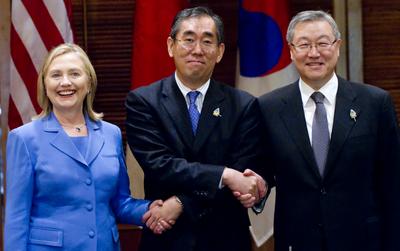The balance of power in East Asia is shifting, presenting new risks to regional stability.

In order to consolidate East Asia cooperation, a sophisticated network of regional partnerships should be established among the EAS members. The key features of this network should be the dual pillars of a strengthened ASEAN on the one hand and China–Japan–South Korea trilateral leadership on the other. A stronger ASEAN and more proactive leadership by China, Japan, and South Korea will allow for more meaningful interaction to consolidate regional cooperation. China, Japan, and South Korea have made some significant progress in strengthening their cooperation. For example, rather than meeting on the fringe of ASEAN+3 summits they have started to hold independent trilateral summit meetings, and they are now creating a joint secretariat to coordinate trilateral cooperation. The three nations are likely to have more opportunities to consult, not just on trilateral issues but also on broader issues of regional cooperation.
Giving China a share of the driver’s seat can be seen as a strategy for bringing it into the fold as a regional stakeholder while recognizing its rapid economic growth and increased military power. China would then be balanced by Japan and South Korea, both of which have strong alliances with the United States. For ASEAN, this approach balances its high stakes in Chinese markets with its disputes with China in the South China Sea. By having the three northeast Asian nations take joint leadership to give substance to inclusive regional cooperation centering upon the EAS — which the United States and Russia will formally join this year — we will be able to address various concerns brought about by the changing balance of power.
Advocates of consolidating regional cooperation have debated various possible approaches. Of these, region-wide cooperation on resources is a practical and meaningful way forward that would allow the nations of East Asia to consolidate regional cooperation and mitigate the likelihood of conflict arising as a result of the shifting balance of power. This cooperation would be centered on the EAS, given that its membership comprises all the right countries, and might entail collaboration in four areas: joint development of energy resources, guidelines for nuclear safety and energy-saving measures, food security, and safety of sea lines of communication.
First, jointly developing energy resources can kill two birds with one stone: it not only helps address energy shortages, it also helps to build confidence among the nations involved. For instance, China and Japan were able to conclude a basic agreement for the joint exploration of natural gas in the East China Sea despite differences in their interpretations of international law. History has shown that when looked at through the lens of a bilateral issue, nationalistic tensions are liable to flare up on both sides, but if viewed through a multilateral lens and conducted as a regional project, the prospects become increasingly viable. For instance, Chinese and Japanese disagreements on oil pipeline routes from Russia might be managed more effectively if they are designed to meet regional needs rather than competing national interests.
Second, regional guidelines for energy safety and energy-saving measures should be developed. Reducing dependence on fossil fuels and fighting against climate change are challenges with implications that transcend borders. East Asia cannot survive without nuclear energy in at least the short term, so regional efforts should be made to strengthen international nuclear safeguards. At the same time, over-reliance on nuclear energy is also dangerous, as the Fukushima crisis has made all too clear, and regional efforts to develop new technologies to utilize renewable energy resources — such as wind, solar, and geothermal energy — should be developed to support the region’s energy needs over the longer term. This will also help to mitigate future resource conflicts as fossil fuel resources become exhausted.
Third, cooperation is needed to ensure regional food security. The population of Asia is growing, especially the middle class, which already numbers more than half a billion people and within the next 20 years is forecast to climb as high as 2.5 billion. This newly emerging middle class will demand more and higher-quality food, which in turn necessitates improved food production technology and the liberalization of agriculture across the region to boost food production efficiency.
Fourth, anxieties over the safety of the sea lines of communication need to be managed to guarantee resource transportation. More than 80 percent of Japan’s primary energy resources are imported from abroad, primarily through sea-based transportation. China heavily relies on energy resources, too, delivered through the Malacca Strait. Since the anxieties over maintaining the safety of the lines represent a shared interest in the region, it should be coordinated as a joint regional exercise.
The shifting balance of power in East Asia presents new risks to regional stability and necessitates the consolidation of regional cooperation. While ASEAN should continue driving, China, Japan, and South Korea should also share in the driving duties. By focusing on concrete areas of cooperation that will have widespread impact across the region, true multilateral cooperation should be able to overcome the challenges of competing national interests that often plague bilateral cooperation, particularly with and among some of the major powers in East Asia.
Hitoshi Tanaka is a senior fellow at the Japan Center for International Exchange (JCIE) and chairman of the Institute for International Strategy at the Japan Research Institute. He previously served as Japan’s deputy minister for foreign affairs.
This article is an extract from East Asia Insights Vol. 6 No. 4 August 2011, which is available in full here, and is reprinted with the kind permission of JCIE.
Nguồn: http://www.eastasiaforum.org/2011/08/15/consolidating-east-asian-cooperation-a-new-role-for-northeast-asia/











